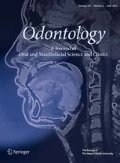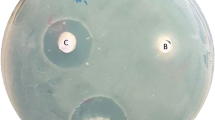Abstract
The objective of the study was to determine the antimicrobial efficacy of three denture adhesives toward Streptococcus oralis, mutans, Prevotella oralis and Fusobacterium nucleatum. Adhesives used were Corega Ultra®, Fixodent Pro Original® and Biotene® Denture Grip. For Streptococcus oralis and Streptococcus mutans, four tubes of Trypticase Soy Broth 10 mL and 1 g denture of adhesive were used. In addition four tubes of Trypticase Soy Broth 10 mL without any denture adhesive was employed as control. For Prevotella oralis and Fusobacterium nucleatum, four tubes of thioglycolate 10 mL and 1 g denture adhesive were used for each one, while four tubes of thioglycolate 10 mL without adhesive served as control. All samples were incubated for 48 h at 37°C. After 48 h, the number of colonies was counted and the mean was extracted as cfu/mL. The results were evaluated with ANOVA on ranked data and Tukey’s post hoc test at α = 0.05. Streptococcus oralis, mutans, Prevotella oralis and Fusobacterium nucleatum showed decreased number of colonies for each denture adhesive compared to the control. Under the conditions of this in vitro study, all the tested denture adhesives showed antimicrobial efficacy. However, in contrast to the hypothesis, there were differences among them. Corega Ultra® and Biotene® Denture Grip were more effective for all the tested oral malodor-related microbes than Fixodent Pro Original®.
Similar content being viewed by others
References
Fiske J, Davis DM, Horrocks P. A self-help group for complete denture wearers. Br Dent J. 1995;178:18–22.
Polyzois GL. An update on denture fixatives. Dent Update. 1983;10:579–83.
Grasso JE. Denture adhesives. Dent Clin North Am. 2004;48:721–33.
Grasso JE. Denture adhesives: changing attitudes. J Am Dent Assoc. 1996;127:90–6.
Shay K. The retention of complete denture In: Zarb GA, Boleneder CL, Carlsson GE, editors. Boucher’s prosthodontic treatment for edentulous patients. 11th ed. St. Louis: Mosby Inc; 1997. p. 400–411.
Kaczmarek U. Management of mouth dryness—review of literature. Czas Stomatol. 2007;2:88–95.
Emilson CG, Thorselius I. Prevalence of mutans streptococci and lactobacilli in elderly Swedish individuals. Scand J Dent Res. 1988;96:14–21.
Carlsson J, Soderholm G, Almfeldt I. Prevalence of Streptococcus sanguis and Streptococcus mutans in the mouth of persons wearing full dentures. Arch Oral Biol. 1969;14:243–9.
Sachdeo A, Haffajee AD, Socransky SS. Biofilms in the edentulous oral cavity. J Prosthodont. 2008;17:348–56.
Oliveira MC, Oliveira VM, Vieira AC, et al. In vivo assessment of the effect of an adhesive for complete dentures on colonization of Candida species. Gerodontology. 2009;27:303–7.
Young A, Jonski G, Rolla G. Inhibition of orally produced volatile sulfur compounds by zinc, chlorhexidine or cetylpyridinium chloride—effect of concentration. Eur J Oral Sci. 2003;111:400–4.
Könönen E, Asikainen S, Alaluusua S, et al. Are certain oral pathogens part of normal oral flora in denture-wearing edentulous subjects? Oral Microbiol Immun. 1991;6:119–22.
Witt JJ, Poore CL. A comparison of two anti-microbial containing dentifrices versus a conventional dentifrice on all day and morning breath status. J Dent Res 1999; 78:(Abst) no 2802.
Tonzetich J. Production and origin of oral malodor: a review of mechanisms and methods of analysis. J Periodontol. 1977;48:13–20.
Myatt GJ, Hunt SA, Barlow AP, et al. A clinical study to assess the breath protection efficacy of denture adhesive. J Contemp Dent Pract. 2002;3:1–9.
Gusberti FA, Gada TG, Lang NP, et al. Cultivable microflora of plaque from full denture bases and adjacent palatal mucosa. J Biol Buccale. 1985;13:227–36.
Ekstrand K, Hensten-Pettersen A, Kullman A. Denture adhesives: cytotoxicity, microbial contamination and formaldehyde content. J Prosthet Dent. 1993;69:314–7.
DeVengencie J, Ng MC, Ford P, Iacopino AM. In vitro evaluation of denture adhesives: possible efficacy of complex carbohydrates. Int J Prosthodont. 1997;10:61–72.
Tenovuo J, Moldoveanu Z, Mestecky J, et al. Interaction of specific and innate factors of immunity: IgA enhances the antimicrobial effect of the lactoperoxidase system against Streptococcus mutans. J Immunol. 1982;128:726–31.
Gerlach RW, Hyde JD, Poore CL, et al. Breath effects of three marketed dentifrices: a comparative study evaluating single and cumulative use. J Clin Dent. 1998;9:83–8.
Tenovuo J. Clinical applications of antimicrobial host proteins lactoperoxidase, lysozyme and lactoferrin in xerostomia: efficacy and safety. Oral Dis. 2002;8:23–9.
He T, Zhou X, Becus MS, et al. Plaque inhibition with denture adhesive use. J Dent Res. 2002;80:(Abst) no 459.
Rajaiah J, Ramji N, Barnes JE, et al. In vitro inhibition of Streptococcus mutans by denture adhesives. J Dent Res. 2003;82:(Abst) no 219.
Ignar RE, Smith SR, Gendreau LD, et al. Denture adhesive inhibits oral malodour causing bacteria. Int Dent J. 2003;53(suppl 5):348.
Barnes JE, Ramji N, Rajaiah J, et al. Antimicrobial efficacy of denture adhesives. J Dent Res. 2004;82:(Abst) no 3065.
Sipsas NV, Papaparaskevas J, Stefanou I, et al. Septic arthritis due to Roseomonas mucosa in a rheumatoid arthritis patient receiving infliximab therapy. Diagn Microbiol Infect Dis. 2006;55:343–5.
Arslan SY, Leung KP, Wu CD. The effect of lactoferrin on oral bacterial attachment. Oral Microbiol Immun. 2009;24:411–6.
Nations SP, Boyer PJ, Love LA, et al. Denture cream. An unusual source of excess zinc, leading to hypocupremia and neurologic disease. Neurology. 2008;71:639–43.
Hedera P, Peltier A, Fink J, et al. Myelopolyneuropathy and pancytopenia due to copper deficiency, high zinc levels of unknown origin II. The denture cream is a primary source of excessive zinc. Neurotoxicology. 2009;30:996–9.
Tezvergil-Mutluay A, Carvalho RM, Pashley DH. Hyperzincemia from ingestion of denture adhesives. J Prosthet Dent. 2010;103:380–3.
Felton D, Cooper L, Duqum I, et al. Evidence-based guidelines for the care and maintenance of complete dentures: a publication of the American College of Prosthodontists. J Prosthodont. 2011;20(Suppl 1):S1–12.
Sampaio-Maia B, Figueiral MH, Sousa-Rodrigues P, et al. The effect of denture adhesives on Candida albicans growth in vitro. Gerodontology. 2011. doi:10.1111/j.1741-2358.2011.00478.x.
Shigli K. Aftercare of the complete denture patient. J Prosthodont. 2009;18:688–93.
Acknowledgments
We thank Professors A. Tsakris and K. Tsiklakis for their excellent scientific support.
Author information
Authors and Affiliations
Corresponding author
Rights and permissions
About this article
Cite this article
Polyzois, G., Stefaniotis, T., Papaparaskevas, J. et al. Antimicrobial efficacy of denture adhesives on some oral malodor-related microbes. Odontology 101, 103–107 (2013). https://doi.org/10.1007/s10266-011-0048-8
Received:
Accepted:
Published:
Issue Date:
DOI: https://doi.org/10.1007/s10266-011-0048-8




